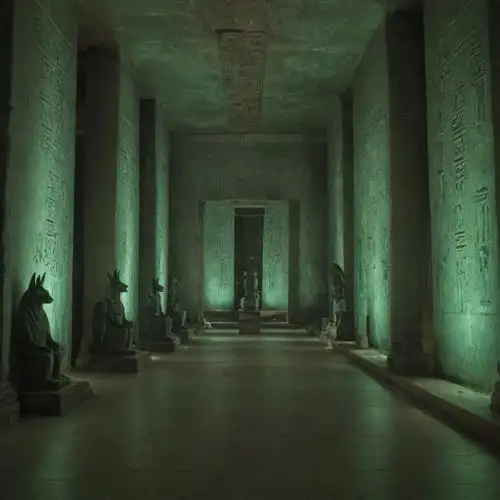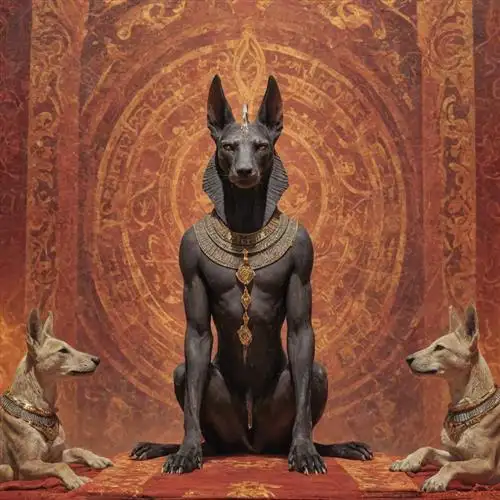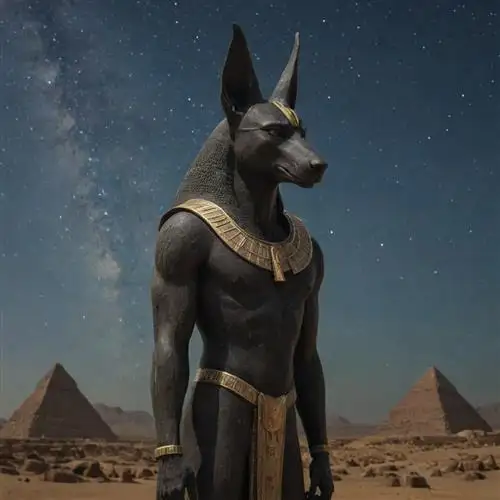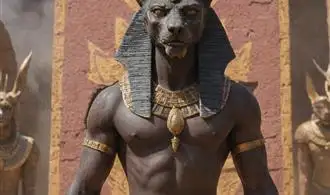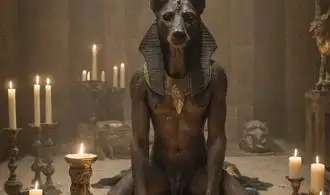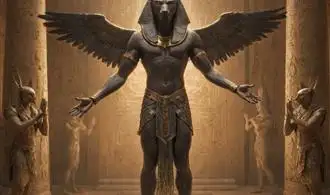
The Enigmatic Jackal-Headed God
Anubis, the iconic jackal-headed deity, has captivated the imagination of ancient Egyptians and modern enthusiasts alike. This enigmatic figure, often associated with mummification and the afterlife, holds a profound significance in the pantheon of Egyptian mythology. Beyond the familiar representations, Anubis's iconography reveals a depth of symbolism and significance that is often overlooked.
One of the most intriguing aspects of Anubis's iconography is the jackal-headed form he is typically depicted in. The jackal, a cunning and adaptable canine, was believed to have a strong connection to the underworld and the transition between life and death. Anubis's jackal-like features were likely chosen to symbolize his role as the guide and protector of the dead, assisting the deceased in their journey through the afterlife.
The color of Anubis's skin, often portrayed as black, holds deep symbolic meaning. Black was associated with the fertile Nile River, the regenerative powers of the earth, and the color of the first land to emerge from the primordial waters of creation. This coloration may have been intended to represent Anubis's role as a deity of resurrection and rebirth, closely tied to the cycle of life, death, and renewal.
Anubis's iconography also includes the depiction of him standing upright, with a human body and jackal head. This anthropomorphic representation, blending human and animal features, highlights the deity's role as a mediator between the physical and spiritual realms. The upright posture and human-like form convey a sense of authority and divine power, while the jackal head maintains the connection to the underworld and the transition from life to death.
In addition to his primary role as the guardian of the dead, Anubis was also associated with other important aspects of Egyptian belief and practice. He was revered as a deity of embalming and mummification, responsible for the careful preparation of the deceased for their journey to the afterlife. Anubis's presence in the mummification process, from the initial evisceration to the final wrapping of the body, ensured the deceased a safe passage to the next world.
The iconography of Anubis also includes the depiction of the deity holding the was scepter, a symbol of power and dominion. This association with authority and control reinforces Anubis's role as a guardian and protector, not only of the dead but also of the living. The was scepter may have been seen as a tool to guide and direct the deceased through the challenges of the afterlife.
Anubis in Egyptian Funerary Rites
Anubis, the jackal-headed deity, holds a profound significance in the intricate tapestry of Egyptian funerary rites. As the god of embalming and the afterlife, Anubis played a pivotal role in guiding the deceased through the perilous journey to the afterlife. His iconography, deeply ingrained within the rituals and beliefs of ancient Egypt, offers a wealth of knowledge for those seeking to understand the cultural and spiritual nuances of this enigmatic figure.
The presence of Anubis was ubiquitous in Egyptian funerary rites, from the moment of death to the final interment. As the protector of the dead, Anubis was responsible for overseeing the embalming process, ensuring the preservation of the physical body. This sacred ritual, carried out by specialized priests, was believed to be essential in preparing the deceased for their journey to the afterlife. Anubis' role in this process was to ensure the proper preservation of the body, safeguarding the soul's return to its earthly vessel.
Beyond the embalming ritual, Anubis also played a crucial role in the final journey of the deceased. As the guide to the underworld, Anubis was responsible for leading the soul to the Hall of Judgement, where the deceased's heart would be weighed against the feather of truth. This pivotal moment, known as the The Unusual Insight Anubis Holds for the Living, determined the individual's fate in the afterlife, with Anubis as the arbiter of this final judgment.
The iconography of Anubis within the funerary rites of ancient Egypt is a testament to the profound reverence and significance accorded to this deity. From the placement of jackal-headed statues at the entrance of tombs to the depiction of Anubis on sarcophagi and funerary papyri, the visual representation of this deity served to invoke his protective powers and guide the deceased through the treacherous realms of the afterlife.
Furthermore, Anubis was often associated with specific funerary rites and objects, such as the canopic jars used to store the embalmed organs of the deceased. The jackal-headed figure of Anubis would be depicted on the lids of these jars, symbolizing his role in safeguarding the essential components of the body during the embalming process.
Symbolic Meanings Behind Anubis's Iconography
Anubis, the ancient Egyptian god with the head of a jackal, is a figure steeped in profound symbolism and iconographic significance. At the heart of Anubis's iconography lies a rich tapestry of meanings and associations that have captivated scholars and enthusiasts alike. Delving into the symbolic meanings behind Anubis's distinctive appearance and imagery can unlock a deeper understanding of the role this deity played in the ancient Egyptian pantheon.
The jackal head of Anubis is not merely a distinctive physical trait but a deliberate and intentional choice that carries great meaning. Jackals were often associated with the desert and the wilderness, areas that were seen as liminal spaces between the world of the living and the realm of the dead. Anubis's jackal-like features thus symbolize his role as a guide and guardian of the dead, one who traverses the boundaries between the mortal and the divine.
The color of Anubis's skin is another important aspect of his iconography. Typically depicted with black or dark-colored skin, Anubis is often associated with the color black, which holds profound significance in ancient Egyptian belief systems. Black was seen as the color of the fertile soil of the Nile Valley, as well as the color of the underworld and the realm of the dead. Anubis's black skin, therefore, symbolizes his connection to the cycle of life, death, and rebirth that was so central to ancient Egyptian theology.
Anubis's association with the jackal and the color black is further reinforced by the specific iconographic elements often depicted alongside him. The scales of justice, which Anubis is sometimes shown holding or presiding over, represent his role as the overseer of the weighing of the heart ceremony, a crucial step in the ancient Egyptian funerary rites. This ceremony determined the worthiness of the deceased, ensuring their safe passage to the afterlife.
In addition to his role as a guardian of the dead, Anubis is also closely linked to the embalming process. The jackal-headed deity is often shown presiding over the embalming table, a reflection of his importance in the mummification rituals that were essential to the ancient Egyptian belief in the afterlife. Anubis's association with the embalming process further reinforces his status as a liminal figure, one who bridges the gap between the earthly and the divine realms.
The Evolution of Anubis Imagery Throughout Egyptian History
Anubis in Modern Art and Popular Culture
Anubis, the ancient Egyptian jackal-headed god, has captured the imagination of artists and pop culture enthusiasts alike. Beyond his traditional depictions in ancient hieroglyphics and mythology, the iconography of Anubis has evolved, finding new expressions in modern art and popular culture.
In the realm of contemporary art, Anubis has become a symbol of fascination and reinterpretation. Numerous artists have drawn inspiration from the god's enigmatic presence, reimagining his form and symbolism through diverse mediums. From the surreal paintings of Salvador Dalí, which incorporate Anubis as a gateway to the subconscious, to the haunting digital illustrations of modern visionaries, the jackal-headed deity has become a canvas for artistic exploration.
The influence of Anubis extends beyond the confines of fine art, permeating the realms of popular culture. In the world of comics and graphic novels, Anubis has found a prominent place, often portrayed as a mysterious and powerful entity. The character's appearance in acclaimed works, such as Neil Gaiman's "The Sandman" series, has introduced Anubis to a wider audience, sparking a deeper appreciation for the god's ancient significance.
The digital age has further amplified the reach of Anubis's iconography. In the world of video games, the jackal-headed god has become a prominent figure, appearing as both a source of inspiration and a formidable adversary. From the strategic gameplay of the "Assassin's Creed" franchise, which features Anubis-inspired characters and settings, to the awe-inspiring boss battles in role-playing games, the god's image has been seamlessly integrated into the interactive experiences that captivate modern audiences.
Moreover, Anubis has become a symbol of fascination in the realm of fashion and design. Clothing lines, jewelry, and accessory collections have incorporated the god's iconography, transforming his ancient likeness into contemporary statements of style and cultural identity. This fusion of ancient Egyptian symbolism and modern aesthetics has contributed to the enduring appeal of Anubis, making him a timeless icon that transcends the boundaries of time and medium.


